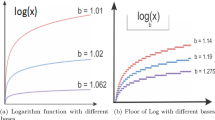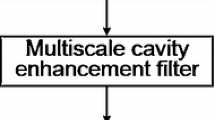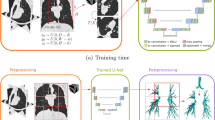Abstract
Airway diseases are frequently related to morphological changes that may influence lung physiology. Accurate airway region segmentation may be useful for quantitative evaluation of disease prognosis and therapy efficacy. The information can also be applied to understand the fundamental mechanisms of various lung diseases. We present a hybrid method to automatically segment the airway regions on 3D volume chest computed tomography (CT) scans. This method uses multi-scale filtering and support vector machine (SVM) classification. The proposed scheme is comprised of two hybrid steps. First, a tubular structure-based multi-scale filter is applied to find the initial candidate airway regions. Second, for identifying candidate airway regions using the fuzzy connectedness technique, the small and disconnected branches of airway regions are detected using SVM classification trained to differentiate between airway and non-airway regions through texture analysis of user-defined landmark points. For development and evaluation of the method, two datasets were incorporated: (1) 55 lung-CT volumes from the Korean Obstructive Lung Disease (KOLD) Cohort Study and (2) 20 cases from the publicly open database (EXACT′09). The average tree-length detection rates of EXACT′09 and KOLD were 56.9 ± 11.0 and 70.5 ± 8.98, respectively. Comparison of the results for the EXACT′09 data set between the presented method and other methods revealed that our approach was a high performer. The method limitations were higher false-positive rates than those of the other methods and risk of leakage. In future studies, application of a convolutional neural network will help overcome these shortcomings.









Similar content being viewed by others
References
Porpodis K et al.: Pneumothorax and asthma. J Thorac Dis 6:S152, 2014
Kiraly AP, Higgins WE, McLennan G, Hoffman EA, Reinhardt JM: Three-dimensional human airway segmentation methods for clinical virtual bronchoscopy. Acad Radiol 9:1153–1168, 2002
Li B, Christensen GE, Hoffman EA, McLennan G, Reinhardt JM: Pulmonary CT image registration and warping for tracking tissue deformation during the respiratory cycle through 3D consistent image registration. Med Phys 35:5575–5583, 2008
Chen B, Kitasaka T, Honma H, Takabatake H, Mori M, Natori H, Mori K: Automatic segmentation of pulmonary blood vessels and nodules based on local intensity structure analysis and surface propagation in 3D chest CT images. Int J Comput Assist Radiol Surg 7:465–482, 2012
Hu S, Hoffman EA, Reinhardt JM: Automatic lung segmentation for accurate quantitation of volumetric X-ray CT images. IEEE Trans Med Imaging 20:490–498, 2001
Kuhnigk J-M, Hahn H, Hindennach M, Dicken V, Krass S, Peitgen H-O: Lung lobe segmentation by anatomy-guided 3 D watershed transform. Proc. Proceedings of SPIE: City
Lee YK et al.: Quantitative assessment of emphysema, air trapping, and airway thickening on computed tomography. Lung 186:157–165, 2008
Mori K, et al.: Lung lobe and segmental lobe extraction from 3D chest CT datasets based on figure decomposition and Voronoi division. Proc. Medical Imaging: City
Lo P, van Ginneken B, Reinhardt JM, Yavarna T, de Jong PA, Irving B, Fetita C, Ortner M, Pinho R, Sijbers J, Feuerstein M, Fabijanska A, Bauer C, Beichel R, Mendoza CS, Wiemker R, Lee J, Reeves AP, Born S, Weinheimer O, van Rikxoort EM, Tschirren J, Mori K, Odry B, Naidich DP, Hartmann I, Hoffman EA, Prokop M, Pedersen JH, de Bruijne M: Extraction of airways from CT (EXACT'09). IEEE Trans Med Imaging 31:2093–2107, 2012
Aykac D, Hoffman EA, McLennan G, Reinhardt JM: Segmentation and analysis of the human airway tree from three-dimensional X-ray CT images. IEEE Trans Med Imaging 22:940–950, 2003
Mori K, Hasegawa J-I, Toriwaki J-I, Anno H, Katada K: Automated extraction and visualization of bronchus from 3D CT images of lung. Proc. Computer Vision, Virtual Reality and Robotics in Medicine: City
Singh H, Crawford M, Curtin J, Zwiggelaar R: Automated 3D segmentation of the lung airway tree using gain-based region growing approach. Proc. International Conference on Medical Image Computing and Computer-Assisted Intervention: City
Sonka M, Park W, Hoffman EA: Rule-based detection of intrathoracic airway trees. IEEE Trans Med Imaging 15:314–326, 1996
Kitasaka T, Mori K, Hasegawa J, Toriwaki J: A method for extraction of bronchus regions from 3D branch tracing and image sharpening for airway tree chest X-ray images by analyzing structural features of the bronchus. Forma 17:321–338, 2002
Tschirren J, Hoffman EA, McLennan G, Sonka M: Intrathoracic airway trees: Segmentation and airway morphology analysis from low-dose CT scans. IEEE Trans Med Imaging 24:1529–1539, 2005
Feuerstein M, Kitasaka T, Mori K: Adaptive branch tracing and image sharpening for airway tree extraction in 3-D chest CT. Proc. Proc Second International Workshop on Pulmonary Image Analysis: City
Schlathoelter T, Lorenz C, Carlsen IC, Renisch S, Deschamps T: Simultaneous segmentation and tree reconstruction of the airways for virtual bronchoscopy. Proc Medical Imaging 2002: City
Lo P, Sporring J, Ashraf H, Pedersen JJ, de Bruijne M: Vessel-guided airway tree segmentation: A voxel classification approach. Med Image Anal 14:527–538, 2010
Bauer C, Eberlein M, Beichel RR: Graph-based airway tree reconstruction from chest CT scans: evaluation of different features on five cohorts. IEEE Trans Med Imaging 34:1063–1076, 2015
Lo P, de Bruijne M: Voxel classification based airway tree segmentation. Proc. Medical Imaging: City
Yano H, Marco F, Kitasaka T, Mori K: Study on bronchus region extraction from 3D chest CT images using loca1 intensity structure analysis and CT value distribution feature. The institute of electronics information and communication, MI2009–13:69–74, 2009
Xu Z, Bagci U, Foster B, Mansoor A, Udupa JK, Mollura DJ: A hybrid method for airway segmentation and automated measurement of bronchial wall thickness on CT. Med Image Anal 24:1–17, 2015
Meng Q, Kitasaka T, Nimura Y, Oda M, Ueno J, Mori K: Automatic segmentation of airway tree based on local intensity filter and machine learning technique in 3D chest CT volume. Int J Comput Assist Radiol Surg:1–17, 2016
Chae EJ, Seo JB, Song JW, Kim N, Park BW, Lee YK, Oh YM, Lee SD, Lim SY: Slope of emphysema index: an objective descriptor of regional heterogeneity of emphysema and an independent determinant of pulmonary function. Am J Roentgenol 194:W248–W255, 2010
Ballard DH: Generalizing the Hough transform to detect arbitrary shapes. Pattern Recogn 13:111–122, 1981
Frangi AF, Niessen WJ, Vincken KL, Viergever MA: Multiscale vessel enhancement filtering. Proc. International Conference on Medical Image Computing and Computer-Assisted Intervention: City
Serra J: Image analysis and mathematical morphology, v. 1. Academic press, 1982
Kong TY, Rosenfeld A: Topological algorithms for digital image processing. Elsevier, 1996
Kimmel R, Shaked D, Kiryati N, Bruckstein AM: Skeletonization via distance maps and level sets. Proc. Photonics for Industrial Applications: City
Telea A, Vilanova A: A robust level-set algorithm for centerline extraction. Proc. Proceedings of the symposium on Data visualisation 2003: City
Udupa JK, Samarasekera S: Fuzzy connectedness and object definition: theory, algorithms, and applications in image segmentation. Graph Models Image Process 58:246–261, 1996
Chang Y, Lim J, Kim N, Seo JB, Lynch DA: A support vector machine classifier reduces interscanner variation in the HRCT classification of regional disease pattern in diffuse lung disease: Comparison to a Bayesian classifier. Med Phys 40:051912, 2013
Chabat F, Yang G-Z, Hansell DM: Obstructive lung diseases: Texture classification for differentiation at ct 1. Radiology 228:871–877, 2003
Kim N, Seo JB, Lee Y, Lee JG, Kim SS, Kang S-H: Development of an automatic classification system for differentiation of obstructive lung disease using HRCT. J Digit Imaging 22:136–148, 2009
Rudyanto RD, Kerkstra S, van Rikxoort EM, Fetita C, Brillet PY, Lefevre C, Xue W, Zhu X, Liang J, Öksüz İ, Ünay D, Kadipaşaogˇlu K, Estépar RSJ, Ross JC, Washko GR, Prieto JC, Hoyos MH, Orkisz M, Meine H, Hüllebrand M, Stöcker C, Mir FL, Naranjo V, Villanueva E, Staring M, Xiao C, Stoel BC, Fabijanska A, Smistad E, Elster AC, Lindseth F, Foruzan AH, Kiros R, Popuri K, Cobzas D, Jimenez-Carretero D, Santos A, Ledesma-Carbayo MJ, Helmberger M, Urschler M, Pienn M, Bosboom DGH, Campo A, Prokop M, de Jong PA, Ortiz-de-Solorzano C, Muñoz-Barrutia A, van Ginneken B: Comparing algorithms for automated vessel segmentation in computed tomography scans of the lung: the VESSEL12 study. Med Image Anal 18:1217–1232, 2014
Xiao C, Staring M, Shamonin D, Reiber JH, Stolk J, Stoel BC: A strain energy filter for 3D vessel enhancement with application to pulmonary CT images. Med Image Anal 15:112–124, 2011
Cortes C, Vapnik V: Support-vector networks. Mach Learn 20:273–297, 1995
Keshani M, Azimifar Z, Tajeripour F, Boostani R: Lung nodule segmentation and recognition using SVM classifier and active contour modeling: a complete intelligent system. Comput Biol Med 43:287–300, 2013
Smola AJ, Schölkopf B: Learning with kernels: Citeseer, 1998
Zheng S, Liu J, Tian JW: A new efficient SVM-based edge detection method. Pattern Recogn Lett 25:1143–1154, 2004 http://image.diku.dk/exact/exact_results.php
Funding
This work was supported by the National Research Foundation of Korea (NRF) grant funded by the Korea government (MSIT) (NRF-2016R1C1B1011105) and a grant (2014-7006) from the Asan Institute for Life Sciences, Asan Medical Center, Seoul, Korea.
Author information
Authors and Affiliations
Corresponding author
Rights and permissions
About this article
Cite this article
Lee, M., Lee, JG., Kim, N. et al. Hybrid Airway Segmentation Using Multi-Scale Tubular Structure Filters and Texture Analysis on 3D Chest CT Scans. J Digit Imaging 32, 779–792 (2019). https://doi.org/10.1007/s10278-018-0158-8
Published:
Issue Date:
DOI: https://doi.org/10.1007/s10278-018-0158-8




